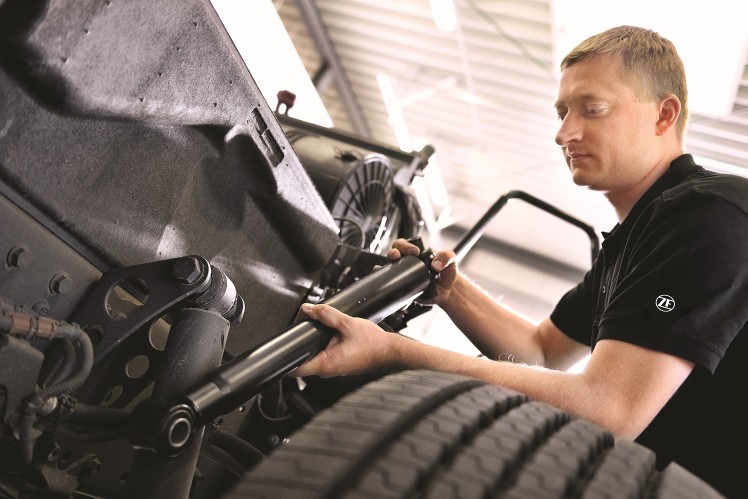Regular Chassis Checks on Trucks Prevent Expensive Repairs - Steering and suspension parts as well as dampers are tested during safety inspections and general inspections
- If damage becomes apparent there, an unscheduled workshop visit follows, and the downtime of the truck is extended
- With the help of ZF expert tips problems can be spotted before they reach critical condition
The suspension and steering components of modern trucks are designed for a long operational life. Nevertheless, the tough conditions in freight traffic can lead to wear and tear or damage. Defects in these vehicle systems are one of the most frequent reasons for truck breakdowns. ZF Aftermarket therefore recommends an exact chassis inspection shortly before the semi-annual safety inspection and the annual general inspection to prevent unscheduled repairs.

There are many indications of damage to the suspension and steering components. But not all can be seen with the naked eye; some require the use of measuring and testing equipment. The first step should therefore be to clean all connecting parts with a dry cloth (without solvent). Make sure that the sealing sleeves are not damaged. Furthermore, the experts at ZF Aftermarket recommend the following test steps in order to detect any damage to the chassis:
Track rods
Any clearance in the thread of the tube or the adjustment sleeve suggest that the thread could be damaged. Then the tie rod must be replaced. This also applies if the tube is damaged or deformed. When checking the clamp and the clamping screw, make sure that the screw is straight and that both the screw head and the nut are firmly seated on the clamp. Corrosion residues on the bolt, nut or clamp should not be deeper than 0.5 mm. If one of these criteria is not met, the tie rod must be replaced.
Ball joints
On these parts, the mechatronics engineer should first check the sealing bellows for holes or cracks. If water and dirt have penetrated into the defective bellows, they cause increased wear and tear and rapid failure of the component. Clamping and retaining rings must be undamaged and should seal the sealing ring correctly against the housing and/or the bolt. A slight escape of grease at the opening of the sleeve is permitted if the sealing bellows are carefully compressed by hand to check the seal. However, if grease escapes from holes or cracks, the joint must be replaced.
The housing, shaft and end cap of the ball joint should not have corrosion marks greater than 1.0 mm deep. Particular attention should be paid to the flanged edges and the end cap walls. They exist in two different designs: Lemförder ball joints in the former joint design (cover with recess) are spring-loaded. They may have an axial clearance of 2.0 mm, measured at the ball journal. If the clearance is greater, the joint must be replaced. To measure the axial clearance, the workshop expert can use a dial gauge mounted on a tripod with a magnetic base.
However, the Lemförder angle joints in the new joint design (curved cover) are not preloaded with a spring, but with a molecular ring. If an axial clearance is detected manually when testing the joint, the joint must be replaced.
V-link / axle strut
The first step is a visual inspection of the molecular bearing for damage, possibly followed by a manual inspection without tools. The mechatronics technician moves the axle strut or the handlebar by hand when installed. The sliding centre bushing of the V-link is susceptible to damage if the cap leaks. The penetration of water, salt and/or dirt leads to accelerated bush wear and thus to failure. Obvious defects require replacement.
Oil leaks in the chassis suspension or driver’s cab suspension
Significant traces of oil on the vibration damper can be traced back to wear on the piston rod seal, which may have been caused by very long operational life or hard use. A loss of damping force leads to reduced driving stability and tyre grip, which is why the damper must be replaced. Workshops can find the right replacement shock absorber for their application via the Sachs online catalog at aftermarket.zf.com or with the ZF Part Finder App.
Another important aspect is the correct adjustment of the load balancing systems (if available). The workshop employee must inspect the bellows and check the air lines for leaks.
Rubber bush deterioration
Increased wear of the rubber bush of the shock absorber can be caused by assembly errors or extreme working conditions. A worn joint part can lead to a rattling or rumbling noise. The shock absorber should then be replaced.
If the workshop checks the truck in this way before the respective official inspection, nothing should stand in the way of issuing the sticker. This also ensures customer satisfaction. After all, nothing is more annoying for a commercial vehicle fleet operator than an unscheduled visit to a workshop followed by a representation to the testing organisation. This additional downtime can quickly lead to costs in the four-digit range due to lost turnover and possible contractual penalties.
- Steering and suspension parts as well as dampers are tested during safety inspections and general inspections
- If damage becomes apparent there, an unscheduled workshop visit follows, and the downtime of the truck is extended
- With the help of ZF expert tips problems can be spotted before they reach critical condition
The suspension and steering components of modern trucks are designed for a long operational life. Nevertheless, the tough conditions in freight traffic can lead to wear and tear or damage. Defects in these vehicle systems are one of the most frequent reasons for truck breakdowns. ZF Aftermarket therefore recommends an exact chassis inspection shortly before the semi-annual safety inspection and the annual general inspection to prevent unscheduled repairs.

There are many indications of damage to the suspension and steering components. But not all can be seen with the naked eye; some require the use of measuring and testing equipment. The first step should therefore be to clean all connecting parts with a dry cloth (without solvent). Make sure that the sealing sleeves are not damaged. Furthermore, the experts at ZF Aftermarket recommend the following test steps in order to detect any damage to the chassis:
Track rods
Any clearance in the thread of the tube or the adjustment sleeve suggest that the thread could be damaged. Then the tie rod must be replaced. This also applies if the tube is damaged or deformed. When checking the clamp and the clamping screw, make sure that the screw is straight and that both the screw head and the nut are firmly seated on the clamp. Corrosion residues on the bolt, nut or clamp should not be deeper than 0.5 mm. If one of these criteria is not met, the tie rod must be replaced.
Ball joints
On these parts, the mechatronics engineer should first check the sealing bellows for holes or cracks. If water and dirt have penetrated into the defective bellows, they cause increased wear and tear and rapid failure of the component. Clamping and retaining rings must be undamaged and should seal the sealing ring correctly against the housing and/or the bolt. A slight escape of grease at the opening of the sleeve is permitted if the sealing bellows are carefully compressed by hand to check the seal. However, if grease escapes from holes or cracks, the joint must be replaced.
The housing, shaft and end cap of the ball joint should not have corrosion marks greater than 1.0 mm deep. Particular attention should be paid to the flanged edges and the end cap walls. They exist in two different designs: Lemförder ball joints in the former joint design (cover with recess) are spring-loaded. They may have an axial clearance of 2.0 mm, measured at the ball journal. If the clearance is greater, the joint must be replaced. To measure the axial clearance, the workshop expert can use a dial gauge mounted on a tripod with a magnetic base.
However, the Lemförder angle joints in the new joint design (curved cover) are not preloaded with a spring, but with a molecular ring. If an axial clearance is detected manually when testing the joint, the joint must be replaced.
V-link / axle strut
The first step is a visual inspection of the molecular bearing for damage, possibly followed by a manual inspection without tools. The mechatronics technician moves the axle strut or the handlebar by hand when installed. The sliding centre bushing of the V-link is susceptible to damage if the cap leaks. The penetration of water, salt and/or dirt leads to accelerated bush wear and thus to failure. Obvious defects require replacement.
Oil leaks in the chassis suspension or driver’s cab suspension
Significant traces of oil on the vibration damper can be traced back to wear on the piston rod seal, which may have been caused by very long operational life or hard use. A loss of damping force leads to reduced driving stability and tyre grip, which is why the damper must be replaced. Workshops can find the right replacement shock absorber for their application via the Sachs online catalog at aftermarket.zf.com or with the ZF Part Finder App.
Another important aspect is the correct adjustment of the load balancing systems (if available). The workshop employee must inspect the bellows and check the air lines for leaks.
Rubber bush deterioration
Increased wear of the rubber bush of the shock absorber can be caused by assembly errors or extreme working conditions. A worn joint part can lead to a rattling or rumbling noise. The shock absorber should then be replaced.
If the workshop checks the truck in this way before the respective official inspection, nothing should stand in the way of issuing the sticker. This also ensures customer satisfaction. After all, nothing is more annoying for a commercial vehicle fleet operator than an unscheduled visit to a workshop followed by a representation to the testing organisation. This additional downtime can quickly lead to costs in the four-digit range due to lost turnover and possible contractual penalties.
MEDIA
CONTACT

